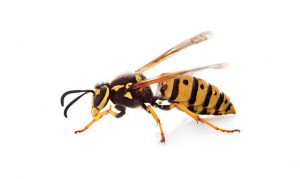
Western yellow jackets are relatively large in size, as queens are nearly ⅘ of an inch in length while workers are a little more than ½ an inch in length. In addition to their large size, this species’ yellow and black stripe pattern makes them easy to recognize. Western yellow jackets tend to be less problematic around homes when their natural insect and plant food sources are abundant, but they readily scavenge for human foods around homes when food sources are low. Western yellow jackets usually establish nesting burrows in the ground soil, but it is not uncommon for them to nest within attics, wall voids, on the underside of eaves and other above ground locations.
Western yellow jackets are frequently spotted in neighborhoods, and their population numbers in public camps and scenic rural areas often surpasses the number of mosquitoes present in these areas. In these conditions, campers and hikers are hardly able to eat their own food without yellow jackets interfering. Heavy populations in both residential and rural areas are believed to result from mild winters and the early arrival of the spring season. In excessively hot climatic conditions, western yellow jackets gravitate to all water sources including spilled drinks and recreational swimming areas. Stings typically cause pain and local swelling and itchiness, but those with venom allergies may suffer anaphylaxis following envenomation. Pest control professionals can eliminate subterranean yellow jacket colonies by pouring insecticide directly into their nest openings, and certain baits have proven effective at controlling populations of western yellow jackets. However, homeowners should never try to remove or destroy nests on their own, as doing so can be hazardous even for trained professionals.
Have you ever found an active yellow jacket nest within or around your home?


